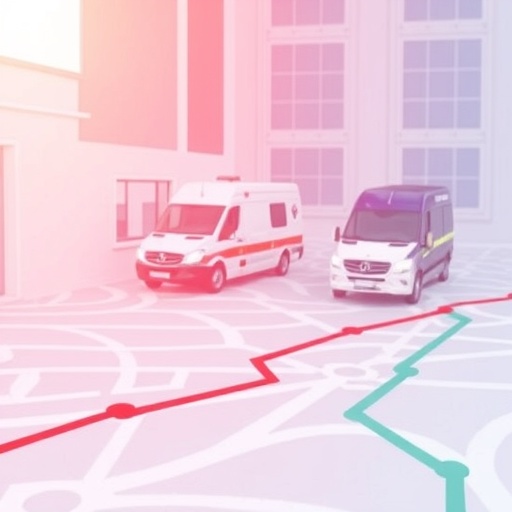In a groundbreaking study set to redefine emergency medical services, researchers Almalki, Aldhahri, and Aljojo have unveiled an innovative approach to optimizing ambulance routing. The intricacies of emergency response during critical moments demand a high level of efficiency, and this research underscores the need to enhance availability and responsiveness in medical emergencies. The authors draw upon advanced algorithms and cutting-edge technology to present a compelling case for their proposed methods, highlighting the potential for saving lives through improved logistical planning in ambulance services.
Their study begins by addressing the perennial challenge of traffic congestion in urban settings, which can severely impede timely medical responses. It is estimated that every minute gained in response time can significantly increase a patient’s chance of survival, particularly in cases of cardiac arrest or severe trauma. The authors present a thoroughly researched narrative on the correlation between swift medical intervention and patient outcomes, establishing a strong foundation for their optimization model.
Employing sophisticated algorithms, the researchers meticulously assess factors that influence ambulance dispatch, including geographic distribution of emergency calls, traffic patterns, and the availability of medical facilities. This multifaceted approach not only accounts for the immediate requirements of a given incident but also considers the broader context of resource allocation across a city. Their model is designed to predict ambulance locations and optimize routes in real-time, leveraging data analytics and machine learning to continuously refine its understanding of situational dynamics.
One of the standout features of this research is its focus on the integration of emergency medical service availability into routing decisions. The authors emphasize that simply striving to minimize travel time is inadequate; a more nuanced approach is necessary to account for various operational constraints. For instance, during peak hours, the number of available ambulances may fluctuate due to increased demand or concurrent emergencies in the area. By incorporating these variables, their model can recommend routes that adapt dynamically to current conditions.
Moreover, this research sheds light on the necessity of enhancing communication pathways between emergency medical teams and dispatch centers. The authors argue that an efficient routing system cannot operate in isolation; it must be part of a cohesive communication strategy that ensures all parties are informed and can make swift decisions. This emphasis on connectivity also includes the need for data-sharing frameworks across different medical facilities and services, allowing for a seamless integration of resources.
The implications of their findings resonate far beyond theoretical constructs. With the ability to simulate various traffic scenarios, the researchers provide a practical example of how their model can be implemented in real-world situations. They illustrate this with a case study, showcasing how a city can leverage their framework to improve its response times systematically. The researchers present graphical data demonstrating the potential reductions in response time, which can empower city planners and emergency service administrators alike.
In addition to logistical improvements, the authors also touch upon the ethical ramifications of their work. With the growing burden of emergency calls on public health systems, commitment to protocols that prioritize patient outcomes becomes paramount. The study highlights that the integration of advanced routing technologies does not just serve to enhance operational efficiency; it reflects a deeper commitment to the communities served by these vital services.
The authors delve into the challenges associated with implementation, acknowledging that resistance to change is a formidable barrier within established systems. However, they present compelling evidence that, when framed correctly, the transition to a data-driven ambulance routing system can yield significant benefits, both in terms of public health and operational cost savings. This realization may incentivize stakeholders to embrace innovative solutions and prioritize advancements in emergency medical service delivery.
As cities continue to expand and populations grow, the timing of an ambulance’s arrival can mean the difference between life and death. The authors argue that the stakes have never been higher for the healthcare industry to adopt modern technology in service of faster response times. Prioritizing advanced analytics in emergency services is not merely an option but a necessity for cities striving to ensure the well-being of their citizens.
In conclusion, this research invites a reevaluation of existing emergency response strategies by introducing a framework that is as practical as it is innovative. The potential for improved ambulance routing optimization based on emergency medical service availability offers a glimpse into the future of healthcare logistics. As technology continues to evolve, so too must the systems that serve our most vulnerable populations during critical emergencies.
The continued exploration of these strategies promises not only to enhance the efficiency of emergency services but also to foster a culture where data-informed decisions lead to improved patient outcomes and overall public health.
This research represents a significant milestone in the quest for enhanced emergency medical services and opens the door to further investigations into how technology can continue to bolster healthcare delivery in fast-paced urban environments.
Subject of Research: Ambulance routing optimization based on emergency medical service availability.
Article Title: Ambulance routing optimization based on emergency medical service availability.
Article References:
Almalki, M., Aldhahri, E. & Aljojo, N. Ambulance routing optimization based on emergency medical service availability.
Discov Artif Intell 5, 297 (2025). https://doi.org/10.1007/s44163-025-00352-3
Image Credits: AI Generated
DOI: 10.1007/s44163-025-00352-3
Keywords: ambulance routing, emergency medical services, optimization algorithms, traffic management, healthcare logistics.




